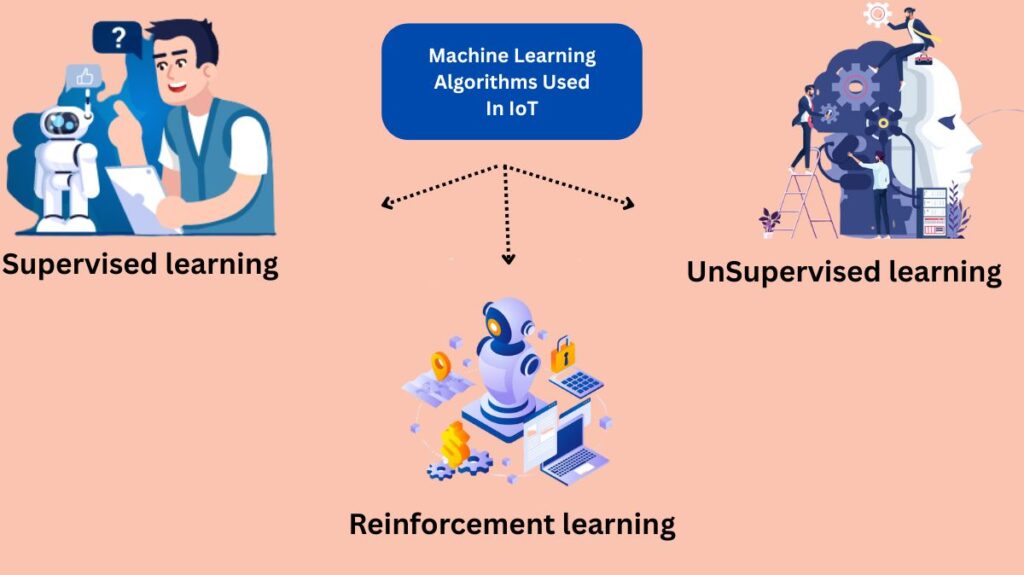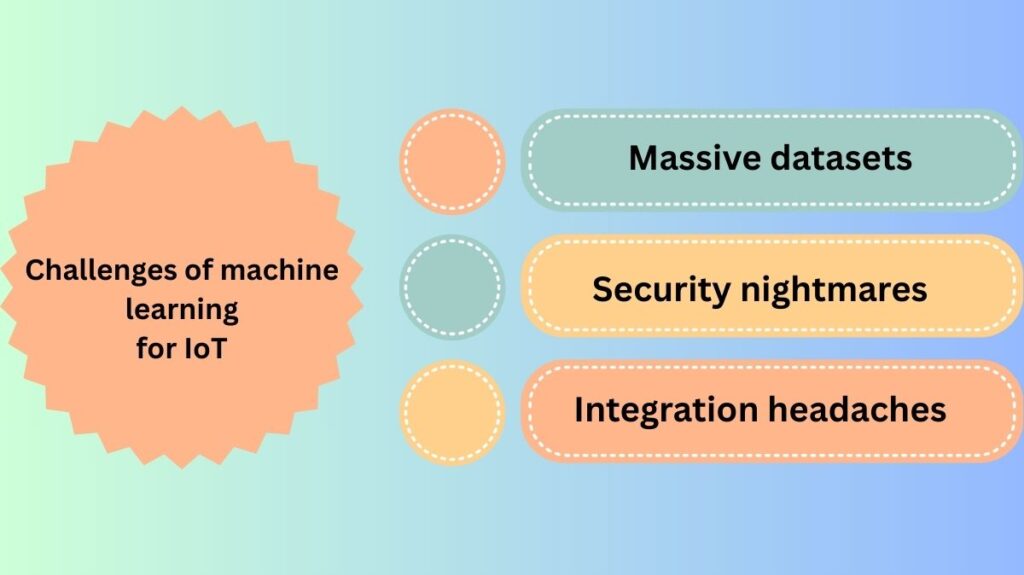Machine learning algorithms used in iot
Fundamentally, machine learning algorithms are extremely powerful pattern recognition tools. Massive volumes of data gathered by IoT devices can be sorted through by machine learning (ML), which can reveal relationships and trends that are hidden from view. However, there are various varieties of these algorithms. Each variety is appropriate for a particular task:

Supervised learning
Consider a teacher presenting labeled examples to a pupil. Supervised learning operates as follows: Its use previously categorized data to train the algorithm. The terms “faulty machine” and “healthy machine” may be used in reference to the Industrial Internet of Things (IIoT). The algorithm gains the ability to recognize patterns and forecast whether labels are suitable for previously unseen data by examining these examples.
This kind of methodology is ideal for applications such as predictive maintenance, whereby IIoT sensor data may be used to identify patterns indicated by the systems and anticipate equipment breakdowns before they occur.
Unsupervised learning
Things start to become intriguing at this point. Unlike supervised learning, unsupervised learning feeds the system input data and output labels. Not having pre-labeled data, the algorithm doesn’t know what traits or patterns to search for. Rather, it explores the data using its own internal logic to find hidden correlations, structures, or abnormalities.
This feature is especially useful in fields like IoT anomaly detection. An unsupervised algorithm analyzing smart city traffic patterns may spot unusual traffic jams or slowdowns that may suggest an accident, blockade, or other event.The algorithm may identify unusual or uncommon actions that might not be present in normal training data because it is not dependent on pre-established labels or patterns.
Reinforcement learning
This method is similar to using rewards to train a dog. The algorithm learns to optimize its behavior over time, engages with its surroundings, and is rewarded for desired actions. It is an effective tool for uses such as smart thermostats. The thermostat may independently modify temperature settings for maximum comfort and efficiency by examining trends of energy use and rewarding users who reduce their consumption.
These are but a handful of the many algorithms that are available to you. However, machine learning’s capacity to manage the vast amount and diversity of data produced by linked devices is what gives it its immense power in the Internet of Things. Consider a wind farm that has hundreds of sensors gathering information on weather, turbine performance, and wind speed. This data can be analyzed by machine learning to forecast weather trends, anticipate maintenance requirements, and maximize energy production.
There are countless applications. Machine learning is making the Internet of Things more intelligent and connected, from improving security in smart homes to optimizing traffic flow in smart cities.
Supervised, unsupervised, and reinforcement learning examples
| Scenario | Best Algorithm | Explanation |
| Predictive maintenance for industrial machines | Supervised Learning (for example, Decision Trees) | Labeled data (for example, “faulty” or “healthy”) allows the algorithm to predict when a machine will fail. |
| Energy consumption prediction in smart homes | Supervised Learning (for example, Neural Networks) | Neural networks learn from historical data (energy usage patterns) to forecast future consumption and optimize energy distribution. |
| Grouping similar pedestrian behaviors in a smart city system | Unsupervised Learning (for example, k-means Clustering) | Clustering helps identify groups of individuals with similar behaviors from unlabeled data (for example, travel patterns). |
| Anomaly detection in IoT network traffic | Unsupervised Learning (for example, Principal Component Analysis) | Detects unusual patterns in network data, identifying potential security breaches or abnormal usage without predefined categories. |
| Autonomous vehicle route optimization | Reinforcement Learning (for example, Q-Learning) | The algorithm learns the best routes by receiving rewards for more efficient paths, adjusting its behavior over time. |
| Smart thermostat energy optimization | Reinforcement Learning (for example, Deep Q-Networks) | Learns and adjusts temperature settings by receiving feedback on energy savings and user comfort, continuously optimizing based on its environment. |
Challenges of machine learning for IoT
Machine learning integration into IoT networks presents both enormous potential and formidable hurdles as the Internet of Things continues its unrelenting march. Everything from smart homes to predictive maintenance might be transformed by ML models’ capacity to glean data from IoT sensors. But first, a few obstacles need to be removed.

Massive datasets
IoT devices have a reputation for being data-hungry. It is practically impossible to fit ML models onto tiny edge devices with little processing power due to their enormous data requirements. This can lead to latency problems because it limits a large portion of the intensive ML lifting to the cloud. Model size and processing requirements can be decreased by using strategies like federated learning, quantization, and pruning.
Security nightmares
IoT networks’ dispersed architecture significantly expands the attack surface for hackers. IoT devices’ ML models may be tainted with faulty data or reverse-engineered. Exposure is reduced by federated learning strategies that maintain local training data. Additionally, blockchain distribution of ML model updates, secure enclaves, and containerization are being investigated by IT security experts.
Integration headaches
IoT environments are a diverse jumble of data types, network protocols, operating systems, and gadgets. It is a constant battle to get ML platforms to function reliably in this maze. Its witnessing the emergence of solutions like machine learning operations (MLOps) platforms and specially designed ML tooling for IoT to assist govern the diversity of IoT.
Read more on What Is Machine Learning In IoT? Advantages And Use Cases
